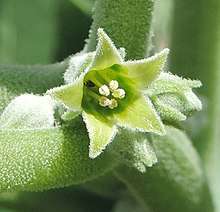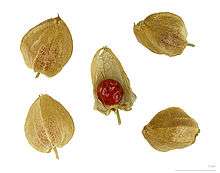Withania somnifera
| Withania somnifera | |
|---|---|
 | |
| Scientific classification | |
| Kingdom: | Plantae |
| Clade: | Angiosperms |
| Clade: | Eudicots |
| Clade: | Asterids |
| Order: | Solanales |
| Family: | Solanaceae |
| Genus: | Withania |
| Species: | W. somnifera |
| Binomial name | |
| Withania somnifera | |
| Synonyms[1] | |
| |


Withania somnifera, known commonly as ashwagandha,[2] Indian ginseng,[3] poison gooseberry,[3] or winter cherry,[2] is a plant in the Solanaceae or nightshade family. Several other species in the genus Withania are morphologically similar.[4] Although commonly used as a medicinal herb in Ayurvedic medicine, there is no conclusive clinical evidence that it is effective for treating any ailment.[4][5]
Description
This species is a short, tender perennial shrub growing 35–75 cm (14–30 in) tall. Tomentose branches extend radially from a central stem. Leaves are dull green, elliptic, usually up to 10–12 cm (4 to 5 in) long. The flowers are small, green and bell-shaped. The ripe fruit is orange-red.
Etymology
The species name somnifera means "sleep-inducing" in Latin.[6] The name, ashwagandha, is a combination of the word ashva, meaning horse, and gandha, meaning smell, reflecting that the root has a strong horse-like odor.[5]
Cultivation
Withania somnifera is cultivated in many of the drier regions of India. It is also found in Nepal, China[7] and Yemen.[8]
Diseases and pests
Withania somnifera is prone to several pests and diseases. Leaf spot disease caused by Alternaria alternata is the most prevalent disease, which occurs in a severe form in Punjab, Haryana, and Himachal Pradesh. A decline in the concentration of its secondary metabolites occurs by leaf spot disease.[9] A treehopper feeds on the apical portions of the stem, making them rough and woody in appearance and brown in colour. The apical leaves are shed and the plant gradually dies.[10] The carmine red spider mite (Tetranychus urticae) is the most prevalent pest of the plant in India.[11] In recent years, this plant have been serving as a new reservoir host for an invasive mealybug species Phenacoccus solenopsis.[12]
Phytochemistry
The main phytochemical constituents are withanolides – which are triterpene lactones – withanolides, withaferin A, alkaloids, steroidal lactones, tropine, and cuscohygrine.[4] Some 40 withanolides, 12 alkaloids, and numerous sitoindosides have been isolated.[4] Withanolides are structurally similar to the ginsenosides of Panax ginseng, leading to a common name for W. somnifera, "Indian ginseng".[4]
Traditional medicine
The plant, particularly its root powder, has been used for centuries in traditional Indian medicine.[4][7] There is insufficient evidence that it has any medicinal effects.[4][5][13] Dietary supplements containing ashwagandha are marketed in the U.S., but there is insufficient evidence they provide any benefit.[4]
References
- ↑ "Withania somnifera (L.) Dunal". Tropicos. Missouri Botanical Garden. Retrieved 25 Feb 2012.
- 1 2 "Withania somnifera". Germplasm Resources Information Network (GRIN). Agricultural Research Service (ARS), United States Department of Agriculture (USDA). Retrieved 2011-10-29.
- 1 2 "Withania somnifera (L.) Dunal". PROTA (Plant Resources of Tropical Africa / Ressources végétales de l’Afrique tropicale) [Online Database]. Wageningen, Netherlands: Gurib-Fakim A. and Schmelzer G. H. Retrieved 2012-08-07.
- 1 2 3 4 5 6 7 8 "Ashwagandha". Drugs.com. 2009. Retrieved 27 August 2017.
- 1 2 3 "Ashwagandha". MedlinePlus, US National Library of Medicine. 26 June 2017. Retrieved 21 December 2017.
- ↑ Stearn, W. T. (1995). Botanical Latin: History, Grammar, Syntax, Terminology and Vocabulary (4th ed.). Timber Press. ISBN 978-0-88192-321-6.
- 1 2 Pandit, S.; Chang, K.-W.; Jeon, J.-G. (February 2013). "Effects of Withania somnifera on the growth and virulence properties of Streptococcus mutans and Streptococcus sobrinus at sub-MIC levels". Anaerobe. 19: 1–8. doi:10.1016/j.anaerobe.2012.10.007. PMID 23142795.
- ↑ Hugh Scott & Kenneth Mason, Western Arabia and the Red Sea, Naval Intelligence Division: London 1946, p. 597 ISBN 0-7103-1034-X.
- ↑ Pati, P. K.; Sharma, M.; Salar, R. K.; Sharma, A.; Gupta, A. P.; Singh, B. (2009). "Studies on leaf spot disease of Withania somnifera and its impact on secondary metabolites". Indian Journal of Microbiology. 48 (4): 432–437. doi:10.1007/s12088-008-0053-y. PMC 3476785. PMID 23100743.
- ↑ Sharma, A.; Pati, P. K. (2011). "First report of Withania somnifera (L.) Dunal, as a New Host of Cowbug (Oxyrachis tarandus, Fab.) In Plains of Punjab, Northern India" (pdf). World Applied Sciences Journal. 14 (9): 1344–1346. ISSN 1818-4952.
- ↑ Sharma, A.; Pati, P. K. (2012). "First record of the carmine spider mite, Tetranychus urticae, infesting Withania somnifera in India" (pdf). Journal of Insect Science. 12 (50): 1–4. doi:10.1673/031.012.5001. ISSN 1536-2442. PMC 3476950. PMID 22970740.
- ↑ Sharma, A.; Pati, P. K. (2013). "First record of Ashwagandha as a new host to the invasive mealybug (Phenacoccus solenopsis Tinsley) in India". Entomological News. 123 (1): 59–62. doi:10.3157/021.123.0114.
- ↑ "Ashwagandha". New York City: Memorial Sloan Kettering Cancer Center. 13 April 2018. Retrieved 26 May 2018.
External links
![]()